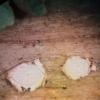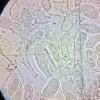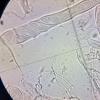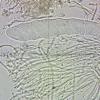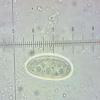
15-12-2025 07:09
 Danny Newman
Danny Newman
indet. Rutstroemiaceae sp. on unk. fallen leavesMc

15-12-2025 21:11
 Hardware Tony
Hardware Tony
Small clavate hairs, negative croziers and IKI bb

15-12-2025 15:54
 Johan Boonefaes
Johan Boonefaes
Unknown anamorph found on the ground in coastal sa

15-12-2025 15:48
 Danny Newman
Danny Newman
Melanospora cf. lagenaria on old, rotting, fallen

15-12-2025 07:05
 Danny Newman
Danny Newman
Pseudosclerococcum golindoi (det: Zotto)near Cosb

15-12-2025 11:49
 Danny Newman
Danny Newman
ITS sequences from the following two collections B

15-12-2025 12:34
 Danny Newman
Danny Newman
indet. Rhytismataceae on oak leafnear Purchase Roa

09-12-2025 12:06
 Andgelo Mombert
Andgelo Mombert
Bonjour,Je recherche l'article concernant Hypobryo
Propolis subviridis?
Rob van Kruining,
25-04-2023 14:13
I found this white Propolis in Norway on a barkless twig of Picea abies.
Size of living and mature spores is 21-25 x 9-12 microns, measured in water.
They contain many small LB's, some of them have 2-3 larger LB's of about 3 microns.
The asci are 150-175 x 12-15 microns.
With the key of H.O. Baral i end up with P. subviridis, but i can't find more info about this one.
Has it changed name or maby put together with another Propolis?
Thanks for helping me out!
Rob
Jason Karakehian,
25-04-2023 16:32
Re : Propolis subviridis?
Hi Rob,
I think that's right. Are there any apothecia with even a faint tinge of green color? Can you please tell us how you found the twig? Was it fallen and the apothecia on the underside of the twig?
I have sequenced one of these pale forms and the sequence came out identical to ones that I made from dark green colored apothecia, so the coloration may be due to environmental factors. However, it would be good to try this again. Do you have any portion of the specimen that you can share with me?
I found a lot of this fungus in Rhode Island, USA, on a pile of smashed dune erosion fencing on the ocean. It had been left there for some time, I guess after a hurricane. I was able to carefully pick the pile apart and note that most of the apothecia that were in shaded parts (lying against the ground, or against other pieces of dunes fencing) were pale-colored. This was true about 80% of the time, but I did find some dark colored ones even though that side of the wood was more or less shaded. They may have been exposed to sunlight reflected off of the sand.
Having said that, I suspect that there may not be a "P. subviridis," just P. viridis.
I'll be publishing more on this within a year. The correct author citation is P. viridis (Fr.) Fr.
I think that's right. Are there any apothecia with even a faint tinge of green color? Can you please tell us how you found the twig? Was it fallen and the apothecia on the underside of the twig?
I have sequenced one of these pale forms and the sequence came out identical to ones that I made from dark green colored apothecia, so the coloration may be due to environmental factors. However, it would be good to try this again. Do you have any portion of the specimen that you can share with me?
I found a lot of this fungus in Rhode Island, USA, on a pile of smashed dune erosion fencing on the ocean. It had been left there for some time, I guess after a hurricane. I was able to carefully pick the pile apart and note that most of the apothecia that were in shaded parts (lying against the ground, or against other pieces of dunes fencing) were pale-colored. This was true about 80% of the time, but I did find some dark colored ones even though that side of the wood was more or less shaded. They may have been exposed to sunlight reflected off of the sand.
Having said that, I suspect that there may not be a "P. subviridis," just P. viridis.
I'll be publishing more on this within a year. The correct author citation is P. viridis (Fr.) Fr.
Hans-Otto Baral,
25-04-2023 17:04

Re : Propolis subviridis?
I wonder a bit although P. viridis is very variable. I have spores *(14)16-22(24) x 5.5-8.5(-11) µm from various collections, with the LBs 2-5 µm diam. Your LBs are max. 2.5 µm on your photo but also only minute LBs.
The large-spored variant (subviridis) (22-31 x 9-12) indeed better concurs with yours but has even larger LBs of 4-7.5 µm diam.
Rob van Kruining,
25-04-2023 19:41
Re : Propolis subviridis?
The twig, with a lot of lichen on it, was still attached to the tree when i found it.
I took it with me because i saw some black knobs on it and put it in a moister box to evolve further. These knobs became Colpoma crispum and 2cm away came these two Propolis sp. up, at the side of the twig.
I can't see any green tinge. Under the white powdery layer and the wood around is more orange-red coloured.
There is still something left to investigate and there are even two more new ones coming up from the wood, so maybe they can be used too later...
If necessary i can send you the specimen of course!
I took it with me because i saw some black knobs on it and put it in a moister box to evolve further. These knobs became Colpoma crispum and 2cm away came these two Propolis sp. up, at the side of the twig.
I can't see any green tinge. Under the white powdery layer and the wood around is more orange-red coloured.
There is still something left to investigate and there are even two more new ones coming up from the wood, so maybe they can be used too later...
If necessary i can send you the specimen of course!
Hans-Otto Baral,
25-04-2023 21:28

Re : Propolis subviridis?
Perhaps the spores would develop larger LBs, who knows. I do not want to study, no time.
Jason Karakehian,
25-04-2023 21:49
Re : Propolis subviridis?
Got it. Thank you for the information, Rob. Don't worry about sending material, it doesn't seem like there is enough for a good duplicate.
Rob van Kruining,
26-04-2023 19:00
Re : Propolis subviridis?
O.k. thanks anyway!
